Countless palm trees thrive in outdoor climates all over the world, but it can be challenging to know which of those species are just as prolific when brought indoors. It can be even more difficult to determine which type of palm tree will do well in your space, depending on how big an area it can grow in and how much light you get.
Do you live in a smaller space with only one or two rooms? Do you live in a massive home, with lots of empty space you are looking to fill? Both factors will determine what types of palm trees you’ll likely end up with indoors.
If you’re wondering what types of indoor palm trees will do well in your interior space, you’ve come to the right place! We’ve hand picked our favorite palm trees that are sure to liven up your indoor living space.
Areca Palm
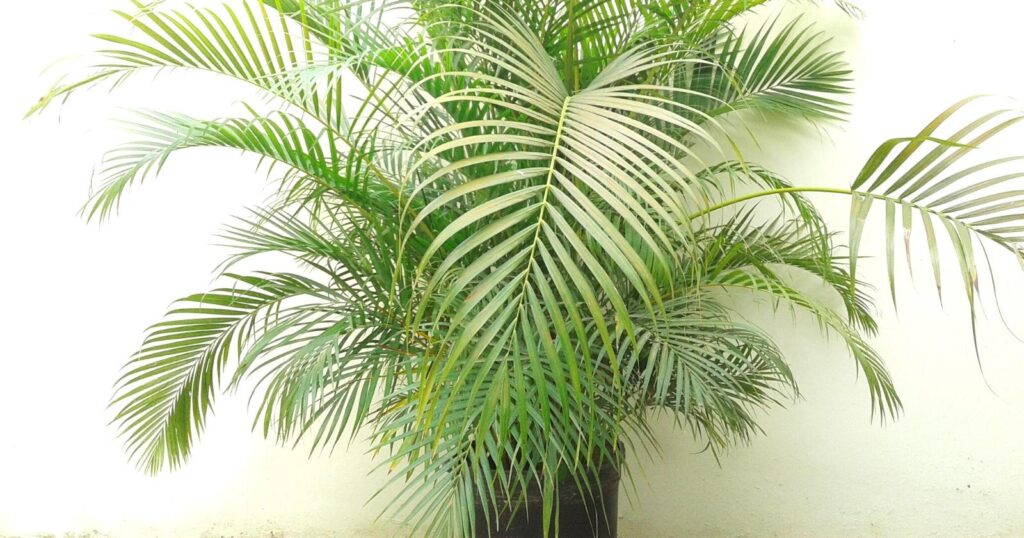
Scientific Name: Dypsis lutescens
- Plant Type: Palm
- Geographic Origin: Madagascar
- Plant Size: Up to 8 feet indoors
- Sun Exposure: Bright, indirect light; can handle direct light
- Plant Zone: 9a to 11
Areca palms are also known as bamboo palms and butterfly palms. These popular houseplants are relatively low-maintenance and effectively lower carbon dioxide levels indoors.
On top of that, these Madagascar natives are beautiful and thrive when placed in bright, indirect light, like a south-facing window.
While these palms are known for tolerating full sunlight when planted outdoors, you should watch for indications of sunburn and move your plant if it looks distressed.
Additionally, areca palms are sensitive to water treated with fluoride or other chemicals, so mist and water your areca palm with distilled water only.
Bottle Palm
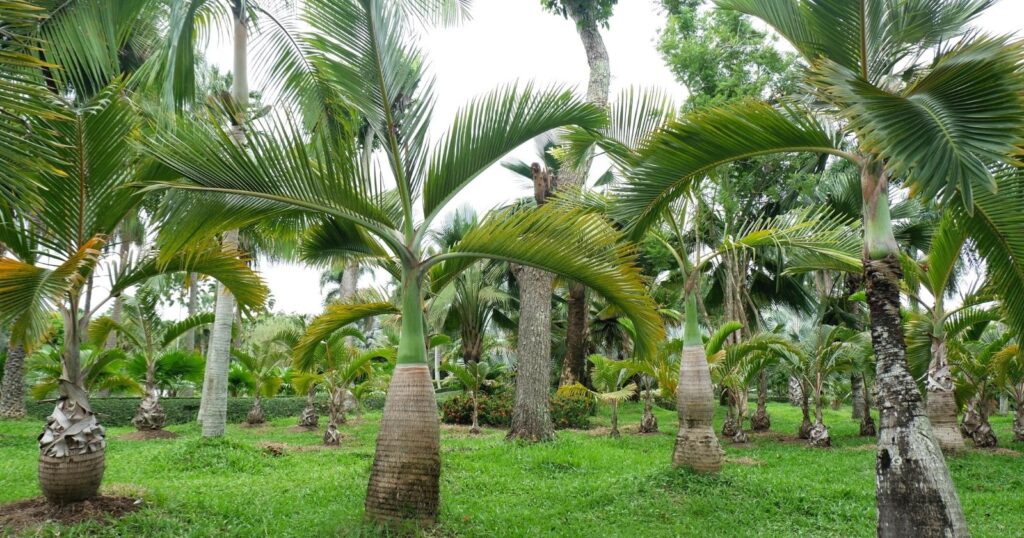
Scientific Name: Hyophorbe lagenicaulis
- Plant Type: Palm
- Geographic Origin: Mascarene Islands
- Plant Size: Up to 12 feet
- Sun Exposure: Bright, indirect light; can handle direct light
- Plant Zone: 10a to 11
Bottle palms are very distinct looking and feature a tall and bulbous trunk with an explosion of bright green fronds.
However, these unique palms are relatively low-maintenance and are an excellent choice for an intermediate plant owner.
Simply find a sunny spot for your bottle frond and keep its soil moist, especially during the warmer months. While your bottle palm may benefit from regular mistings, it’s not required.
Cascade Palm
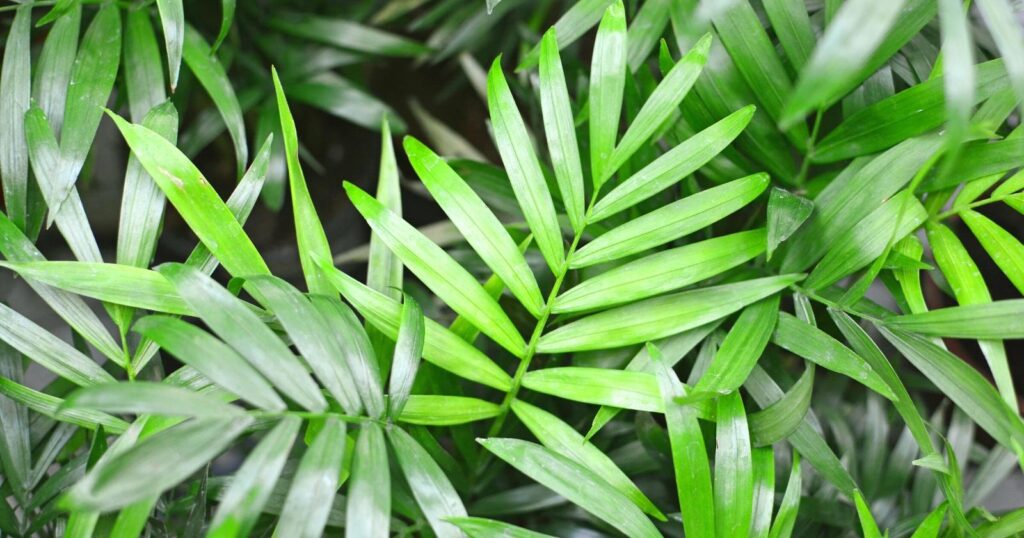
Scientific Name: Chamaedorea cataractarum
- Plant Type: Palm
- Geographic Origin: Southeastern Mexico
- Plant Size: Up to 8 feet
- Sun Exposure: Bright, indirect light; can handle partial shade
- Plant Zone: 9b to 11
Cascade palms, also frequently called cat palms, are among the most popular indoor palms and grow well in various indoor conditions.
Because they prefer more indirect light when planted outdoors, these palms are easy to transition inside and like bright, indirect light, although they’re moderately tolerant of lower lighting conditions.
Somewhat resemblant to an Areca palm, the Cascade palm has long, bushy fronds with bright green foliage and adds a full, tropical feel to any indoor area.
Chinese Fan Palm
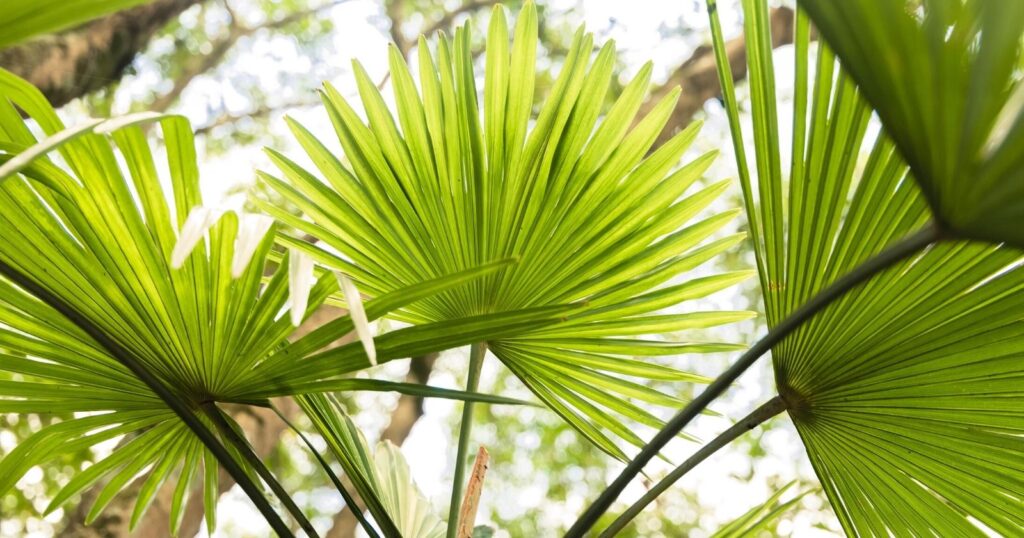
Scientific Name: Livistona chinensis
- Plant Type: Palm
- Geographic Origin: China and southern Japan
- Plant Size: Up to 8 feet
- Sun Exposure: Bright, indirect light; can handle partial shade, especially when young
- Plant Zone: 8a to 11
Chinese fan palms are striking plants with upright, fan-shaped fronds with a bright, glossy green color and are often dried for use in dried flower bouquets.
These palms are lower-maintenance and only need to be watered once the soil begins to dry out. They’re also relatively hardy and can tolerate cooler temperatures than other palm varieties native to warmer climates.
Your Chinese fan palm will do best in an area that receives bright, indirect light but can typically handle lower lighting conditions.
Christmas Palm
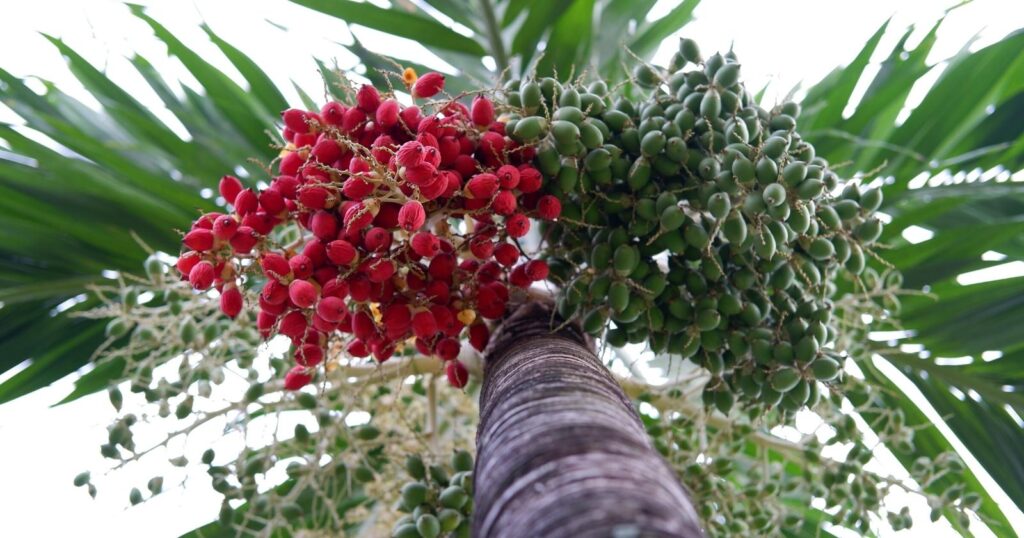
Scientific Name: Adonidia merrillii
- Plant Type: Palm
- Geographic Origin: Small Philippine islands north of Malaysia and Indonesia
- Plant Size: Up to 6 feet
- Sun Exposure: Bright, indirect light; can handle direct light
- Plant Zone: 10a to 11
Christmas palms are extremely popular outdoor palms, but this palm variety also does well when growing indoors. In fact, their sensitivity to the cold makes them an ideal candidate to be brought inside during the colder months of the year.
The Christmas palm gets its name from its berries that turn bright red during winter, around the holidays.
These palms appreciate bright, indirect sunlight but are tolerant of extremely bright light and love the hot sun. Christmas palms also tend to be more drought tolerant and only need to be watered when the first inch or two of soil dries out.
European Fan Palm
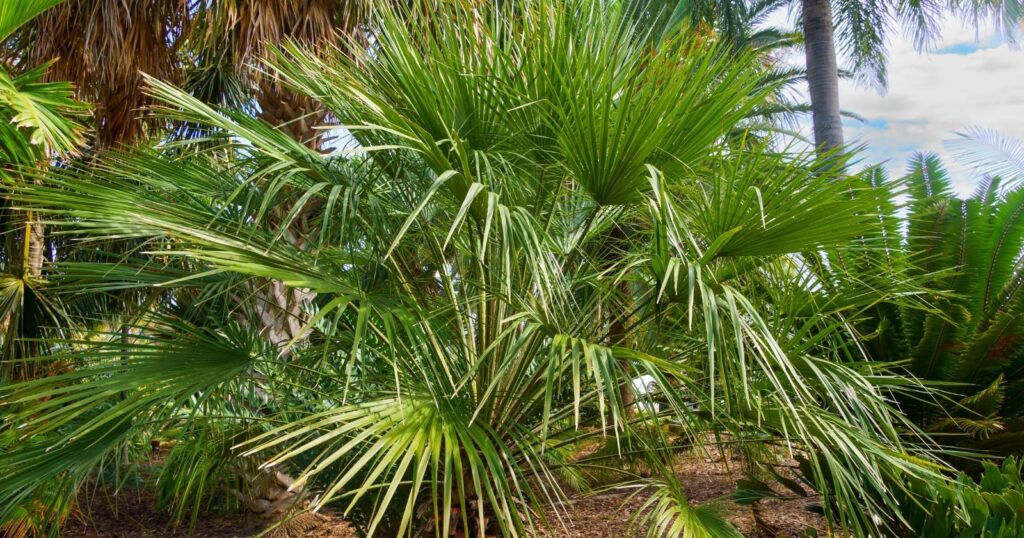
Scientific Name: Chamaerops humilis
- Plant Type: Palm
- Geographic Origin: Mediterranean region of Europe
- Plant Size: up to 15 feet
- Sun Exposure: bright, indirect light; can handle direct light
- Plant Zone: 7b to 11
European fan palms are the perfect choice if you have plenty of space for these beauties to grow. A relatively bushy palm, they can grow to be nearly ten feet wide once fully mature.
However, despite their size, these palms don’t require much care. Their primary need is bright, indirect light, and these palms can handle the full heat of the sun, so feel free to place them in the brightest area of your house.
They also don’t require as much humidity as other palm varieties and must be watered once the top few inches of soil have dried out.
Fishtail Palm
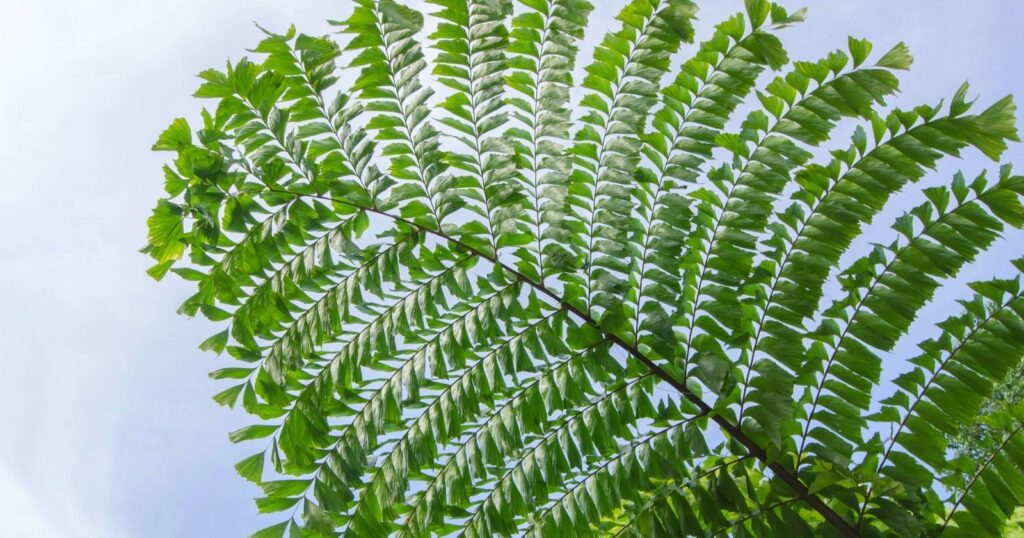
Scientific Name: Caryota mitis
- Plant Type: Palm
- Geographic Origin: Southeast Asia and India
- Plant Size: Up to 10 feet
- Sun Exposure: Bright, indirect light; can handle direct light
- Plant Zone: 8b to 11
Fishtail palms are tall and unique-looking palms and can make a statement in any room they’re placed in. However, these palms are slightly fussier than some other plants on this list and are recommended for more experienced houseplant owners.
Requiring a high level of humidity and soil moisture at all times, you’ll want to keep your fishtail palm in a soil mixture that retains water while allowing for enough drainage to avoid root rot.
Consider keeping your fishtail palm over a rock tray filled with water to aid in humidity. If you feel that your fishtail palm is unhappy, try finding an area of your house with brighter light and misting it several times a week.
Kentia Palm
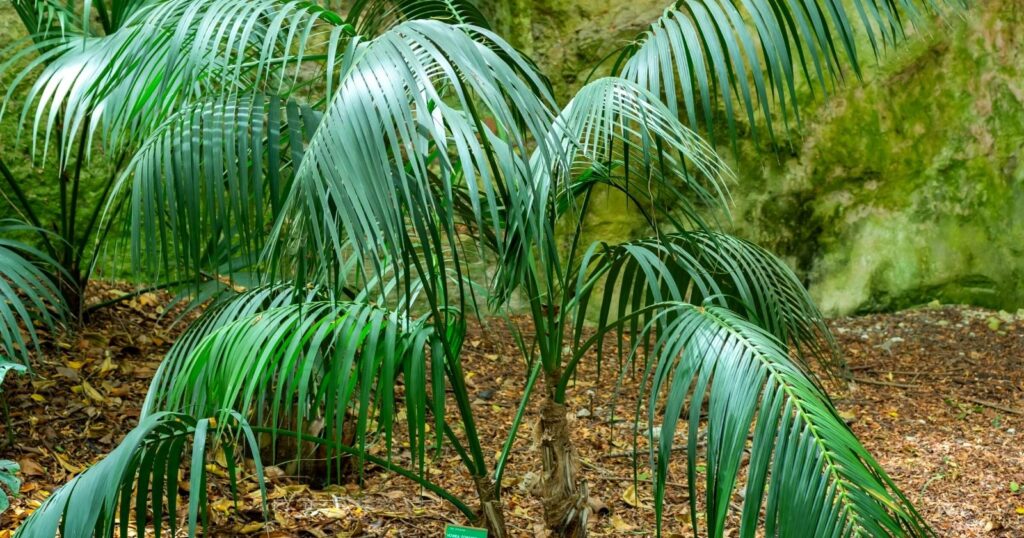
Scientific Name: Howea forsteriana
- Plant Type: Palm
- Geographic Origin: Lord Howe’s Island near Australia
- Plant Size: Up to 8 feet
- Sun Exposure: Bright, indirect light; can handle direct light
- Plant Zone: 9b to 11
Kentia palms look very similar to Sentry palms, another common plant on this list, but differ slightly in their care. Kentia palms are slightly easier to care for due to less intensive watering requirements.
Allow the soil of your Kentia palm to dry out completely between waterings, especially in the winter months.
Kentia palms are an excellent option for people whose homes don’t get bright light, as these palms are relative shade lovers. Preferring indirect light to partial shade, be careful not to leave Kentia palms in direct sunlight, or the leaves might burn.
Lady Palm
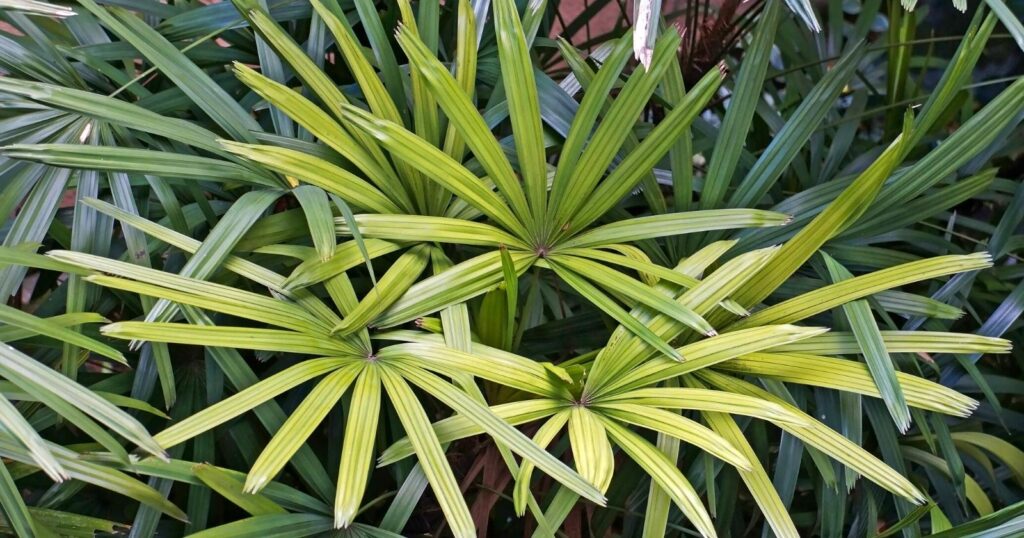
Scientific Name: Rhapis excelsa
- Plant Type: Shrub
- Geographic Origin: Southeast area of China
- Plant Size: Up to 6 feet
- Sun Exposure: bright, indirect light; can handle partial shade
- Plant Zone: 8b to 11
Also commonly called bamboo palms, Lady palms are beautiful and elegant plants that are considered a more low-maintenance palm variety. They appreciate bright, indirect light, but these palms will likely do just fine in an area of the house that gets bright, indirect to low light.
Slightly more drought tolerant than some other palm varieties, lady palms only need to be watered when the first one or two inches of soil feel dry.
Lipstick Palm
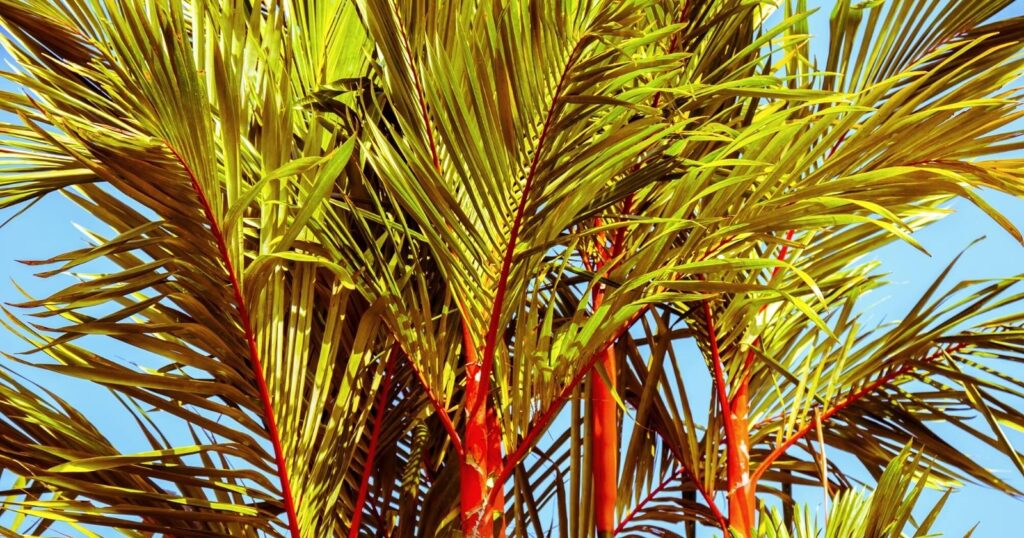
Scientific Name: Cyrtostachys renda
- Plant Type: Palm
- Geographic Origin: Malaysia and the island of Sumatra
- Plant Size: Up to 35 feet
- Sun Exposure: Bright, indirect light; can handle direct light once mature
- Plant Zone: 10b to 11
The lipstick palm is famed for its bright red stalks and green, feathery fronds. These palms make perfect houseplants because they can grow to be quite large, and their red hue makes them a statement plant.
However, this palm may be preferable for a more established plant owner, as they require a high level of attention. Soil should be kept moist at all times, and regular misting is recommended.
These palms love bright, indirect light but can be sensitive to the sun when young.
Majesty Palm
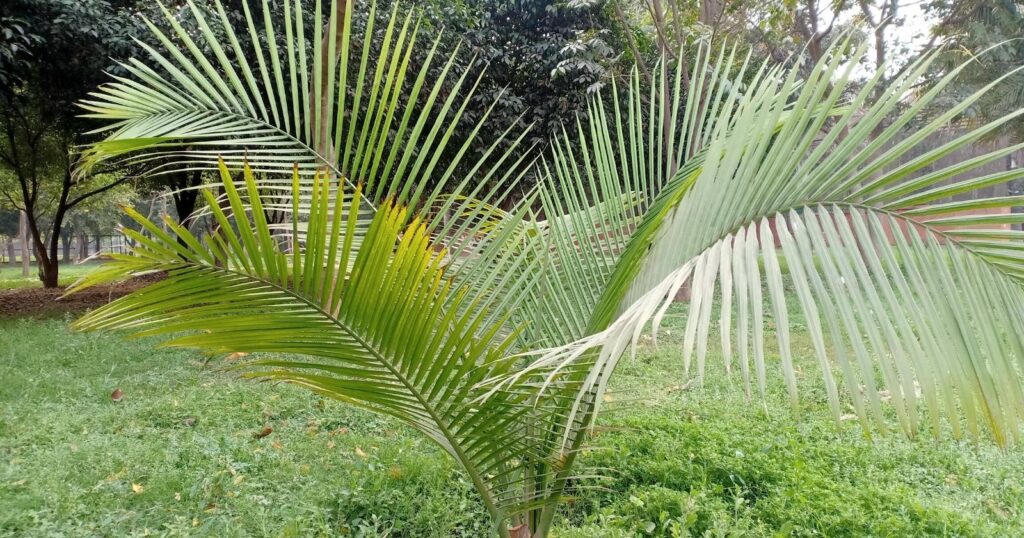
Scientific Name: Ravenea rivularis
- Plant Type: Palm
- Geographic Origin: Madagascar
- Plant Size: Up to 20 feet
- Sun Exposure: bright, indirect light; can handle direct light
- Plant Zone: 9b to 11
One of the most beautiful and rewarding palms, the Majesty palm is aptly named for its tall and elegant feathering fronds.
This palm doesn’t require much upkeep for how beautiful it is, and you should allow the top several inches of soil to dry out before watering. However, these palms do thrive in bright, indirect light, and you may be disappointed with your Majesty palm’s growth if it’s left in indirect light or partial shade.
Needle Palm
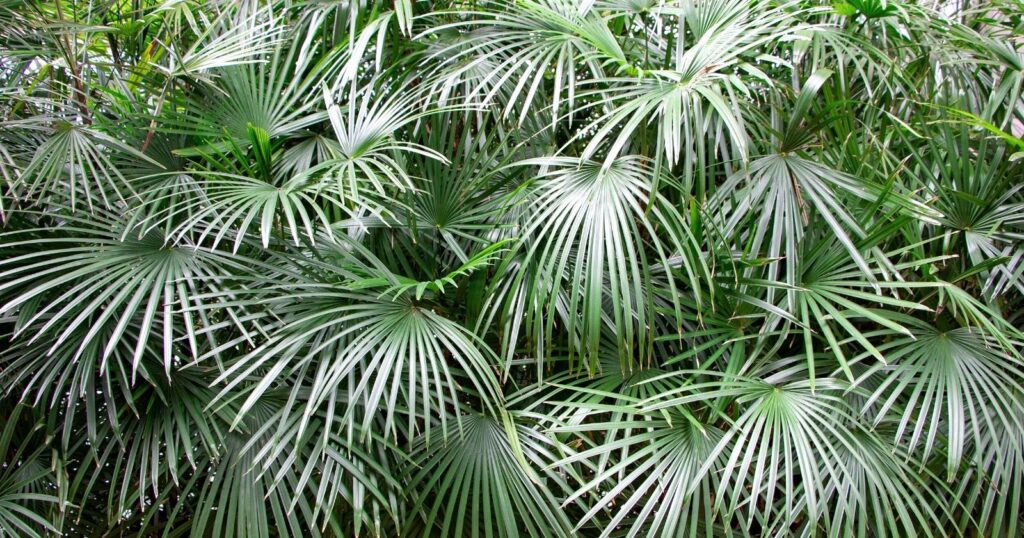
Scientific Name: Rhapidophyllum hystrix
- Plant Type: Perennial shrub
- Geographic Origin: Southeastern United States
- Plant Size: Up to 8 feet
- Sun Exposure: bright, indirect light; can handle partial shade
- Plant Zone: 5b to 11
Another “palm” that is not actually a palm, the needle palm, is an extraordinarily low-maintenance and rewarding plant.
Needle palms can handle a wide range of light and watering conditions, which is part of what marks them such desirable houseplants. They don’t need frequent watering once established, and while they prefer bright, indirect light, these plants will do just fine with moderate shade.
Parlor Palm
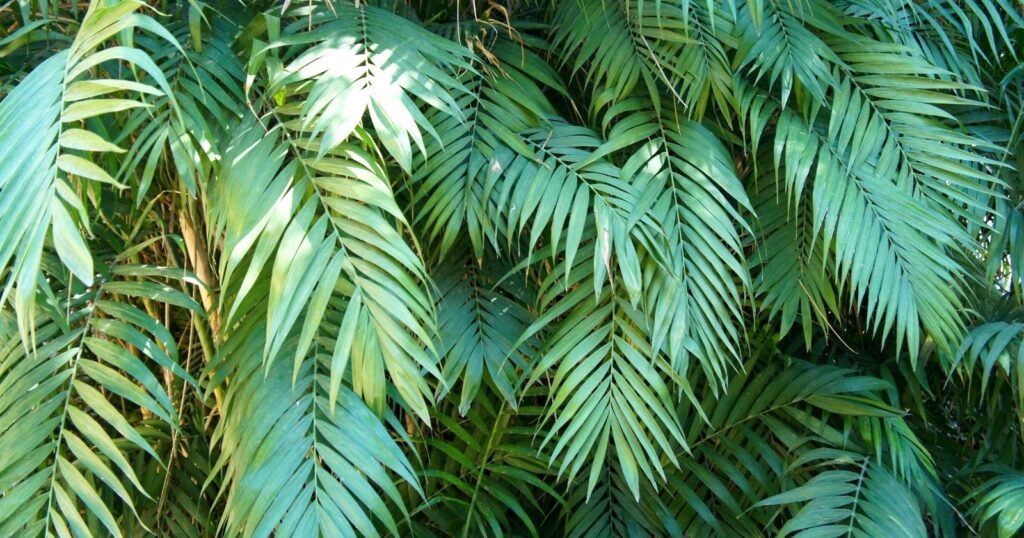
Scientific Name: Chamaedorea elegans
- Plant Type: Palm
- Geographic Origin: Guatemala
- Plant Size: Up to 6 feet
- Sun Exposure: Bright, indirect light; can handle partial shade
- Plant Zone: 9b to 11
Parlor palms are popular houseplants because they’re relatively easy to care for, can thrive in a variety of conditions, and can be planted in everything from a four-inch pot to a large container.
Parlor palms have a classic palm look and are more tolerant of adverse conditions than other palms. While they thrive in bright, indirect light, parlor palms can be quite happy if they’re kept in areas of your home that receive less sunlight.
Ponytail Palm
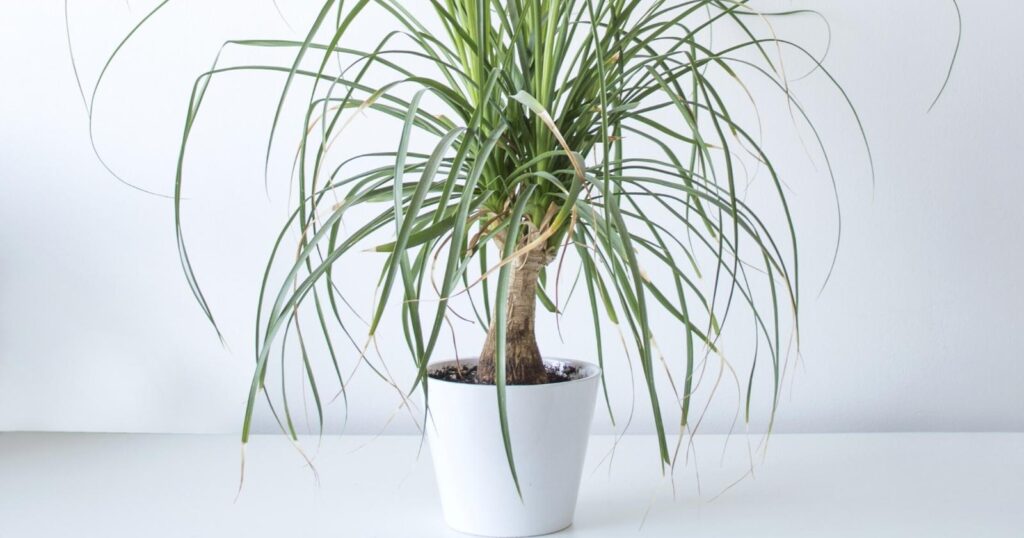
Scientific Name: Beaucarnea recurvata
- Plant Type: Arecaceae
- Geographic Origin: Mexico
- Plant Size: Up to 30 feet
- Sun Exposure: Bright, indirect light; can handle direct light
- Plant Zone: 8b to 11
Ponytail palms, also called pigtail palms, feature a short, bulbous trunk with dark green, wispy fronds. These cute palms are common houseplants because of their low-maintenance needs. In fact, ponytail palms are an excellent choice for beginner palm owners.
The low-maintenance nature of this plant can be attributed to the fact that it is a member of the Agave family, not a palm, which is why this plant is so much more drought tolerant.
Pygmy Date Palm
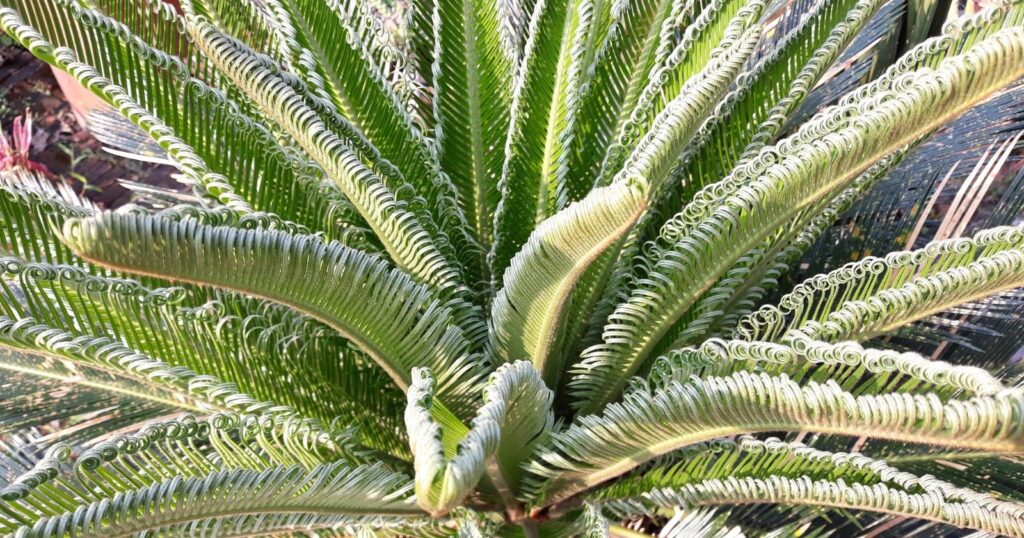
Scientific Name: Phoenix roebelenii
- Plant Type: Palm
- Geographic Origin: Southern China
- Plant Size: Up to 10 feet
- Sun Exposure: bright, indirect light; can handle partial shade
- Plant Zone: 8b to 11
Pygmy date palms are one of the best palm options if you have a home that gets slightly less sunlight. While pygmy date palms will thrive in bright, indirect light, they are relatively tolerant of lower lighting conditions.
In addition, these palms are more drought tolerant than some other palm varieties, which makes them a relatively easy plant to care for.
Ruffled Fan Palm
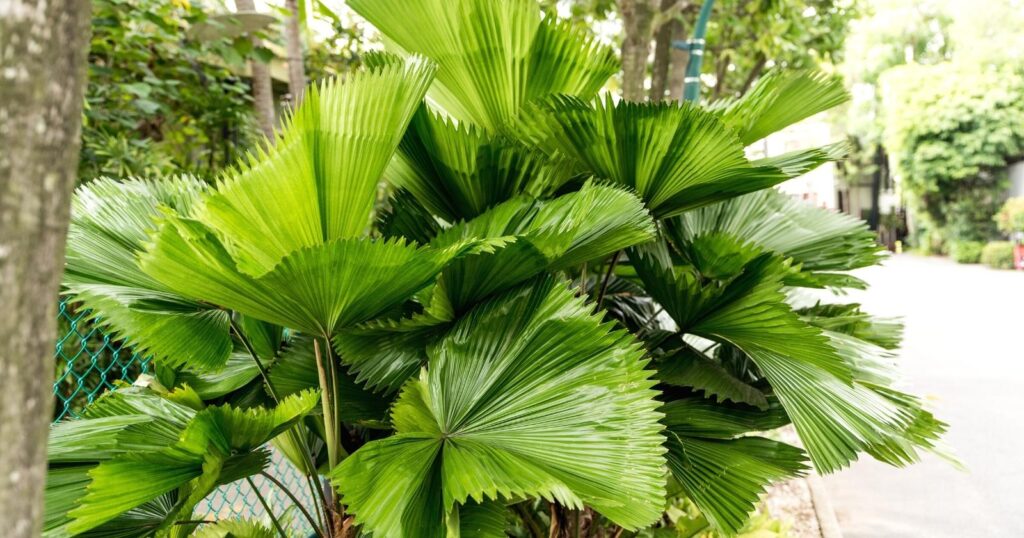
Scientific Name: Licuala grandis
- Plant Type: Palm
- Geographic Origin: Vanuata Islands near Australia
- Plant Size: Up to 6 feet
- Sun Exposure: Indirect light; tolerant of partial shade
- Plant Zone: 10a to 11
Ruffled fan palms are exceptionally beautiful, and if you’re fortunate enough to get your hands on one, you’ll understand why they’re so coveted as houseplants.
These palms are an excellent choice for houses with less sunlight, as they’re tolerant of low light conditions.
However, you should be aware that ruffled fan palms may not be the best choice for households with pets and small children, as the spines of these palms can be quite sharp.
Sago Palm
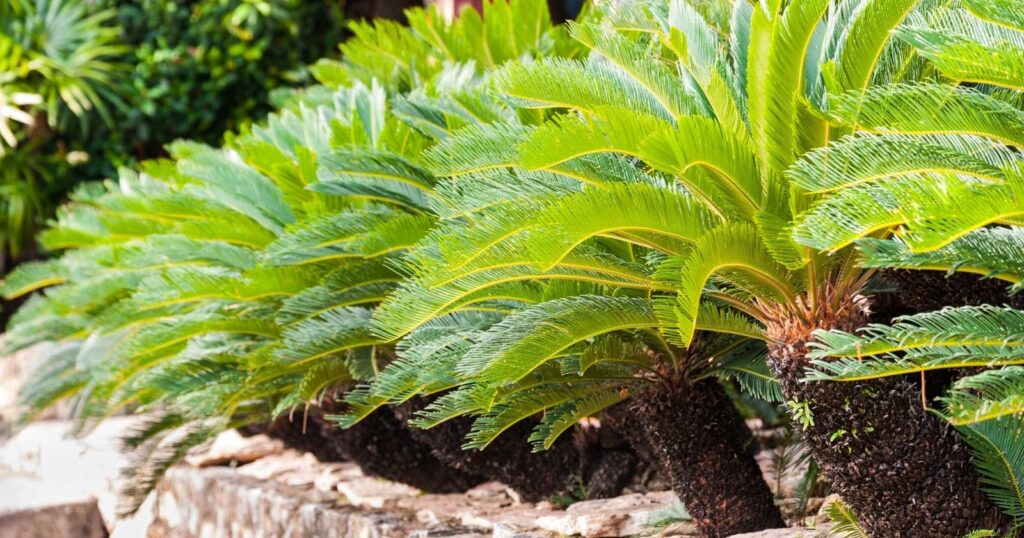
Scientific Name: Cycas revoluta
- Plant Type: Shrub
- Geographic Origin: Japan
- Plant Size: Up to 10 feet
- Sun Exposure: Bright, indirect light
- Plant Zone: 7b to 11
Sago palms are striking but slightly demanding plants, and without the appropriate amount of sunlight, they are likely not to thrive. However, if you keep your Sago palm in bright, indirect light, you will be rewarded with a statement plant that will draw the eye.
Like the Lady palm, the Sago palm is a perennial shrub and not a true palm. However, like most true palms, Sago palms are highly susceptible to root rot, so you’ll want to only water when the top inch of soil feels dry.
Sentry Palm
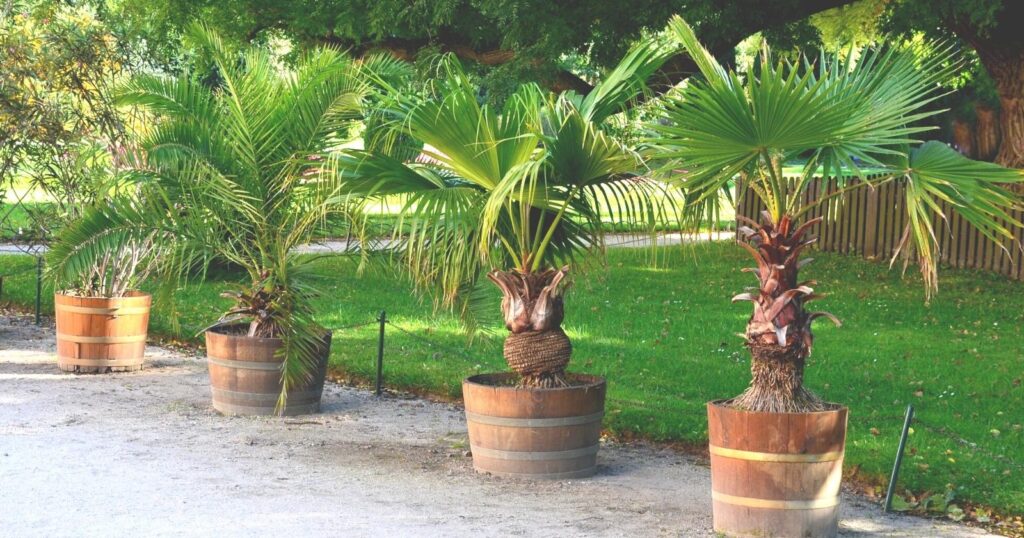
Scientific Name: Howea belmoreana
- Plant Type: Palm
- Geographic Origin: Lord Howe’s Island off the coast of Australia
- Plant Size: Up to 8 feet
- Sun Exposure: Bright, indirect light; can handle partial shade
- Plant Zone: 9b to 11
Sentry palms, also called Belmore palms, strongly resemble Kentia palms as these two palms belong to the same family.
These houseplants feature the classic feather-fronded palm and are popular because they can be kept very small with pruning or grow into larger containers.
However, Sentry palms can be quite demanding and require consistently high humidity levels and will burn if they’re left in direct sunlight. Keep these palms in a partially shaded area that receives indirect sunlight, and make sure the soil is kept moist at all times.
Queen Palm
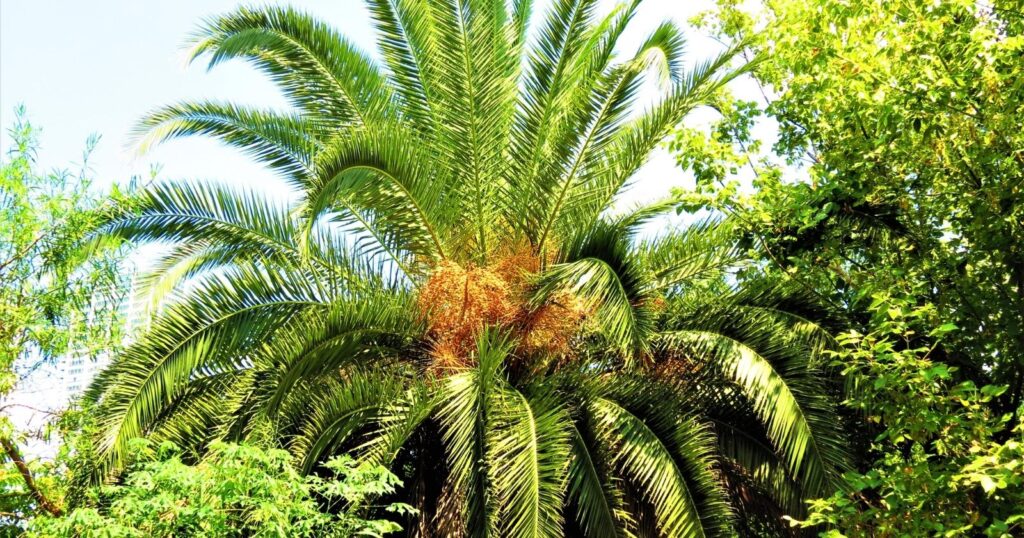
Scientific Name: Syagrus romanzoffiana
- Plant Type: Palm
- Geographic Origin: South American woodlands of Brazil and Argentina
- Plant Size: Up to 50 feet outdoors
- Sun Exposure: Bright, direct light
- Plant Zone: 8b to 11
Queen palms are the ideal house plant to add to your collection if you have a spot that gets too bright of light for other plants. There’s virtually no such thing as too much sun for Queen palms, whose fronds are not known to sunburn and thrive with as much light as possible.
These classic-looking palms are relatively drought-tolerant and would rather be underwatered than over.
When grown outside, Queen palms reach heights of 50 feet and can grow quite tall indoors when cared for properly.
Yucca Palm
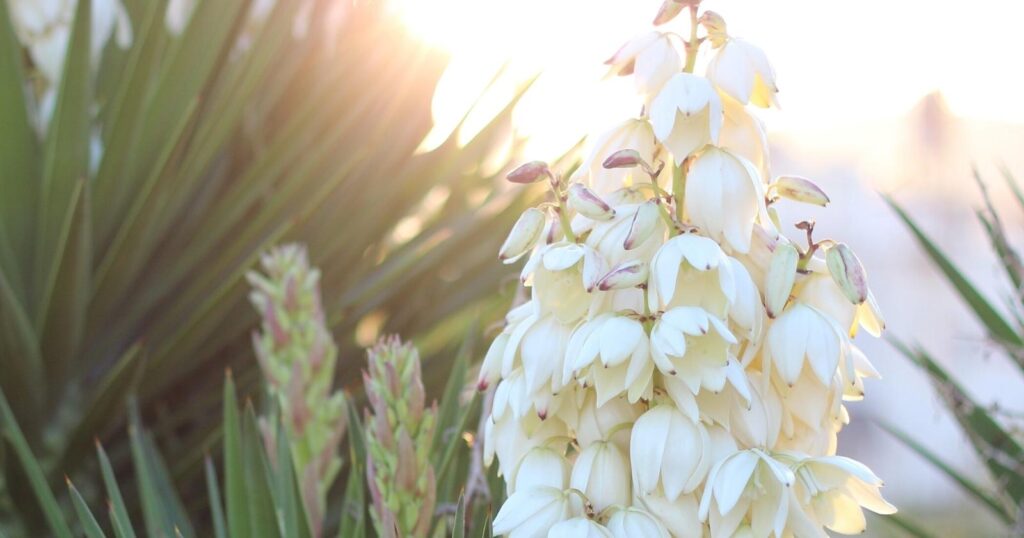
Scientific Name: Yucca elephantipes
- Plant Type: Herbaceous perennial
- Geographic Origin: North America and the Caribbean
- Plant Size: Up to 30 feet
- Sun Exposure: Bright, indirect light; cannot handle direct light
- Plant Zone: 9 to 11
Yucca plants are not technically palms, although they are often called yucca palms because of their palm-like growing pattern.
Not only do Yucca palms bare a physical resemblance to genuine palms, but these plants have very similar care requirements.
Yucca thrives with bright, indirect light, although they may get sunburnt if you expose them to direct sunlight. They are also prone to root rot, like true palms, and do best when you allow the soil to dry out between waterings.
Wrap Up
After reading this list about the types of indoor palm trees, you’re probably ready to run to your local nursery and grab a few to add to your houseplant collection.
But remember that for these palm trees to survive, you should select a plant that will thrive in your available conditions. For example, most palms do best in sunny, humid areas, so a place near a window is often a good choice.
However, other palms are more tolerant of shade and can survive without bright, indirect sunlight. Take into consideration the needs of the above palms when deciding which one is right for you.

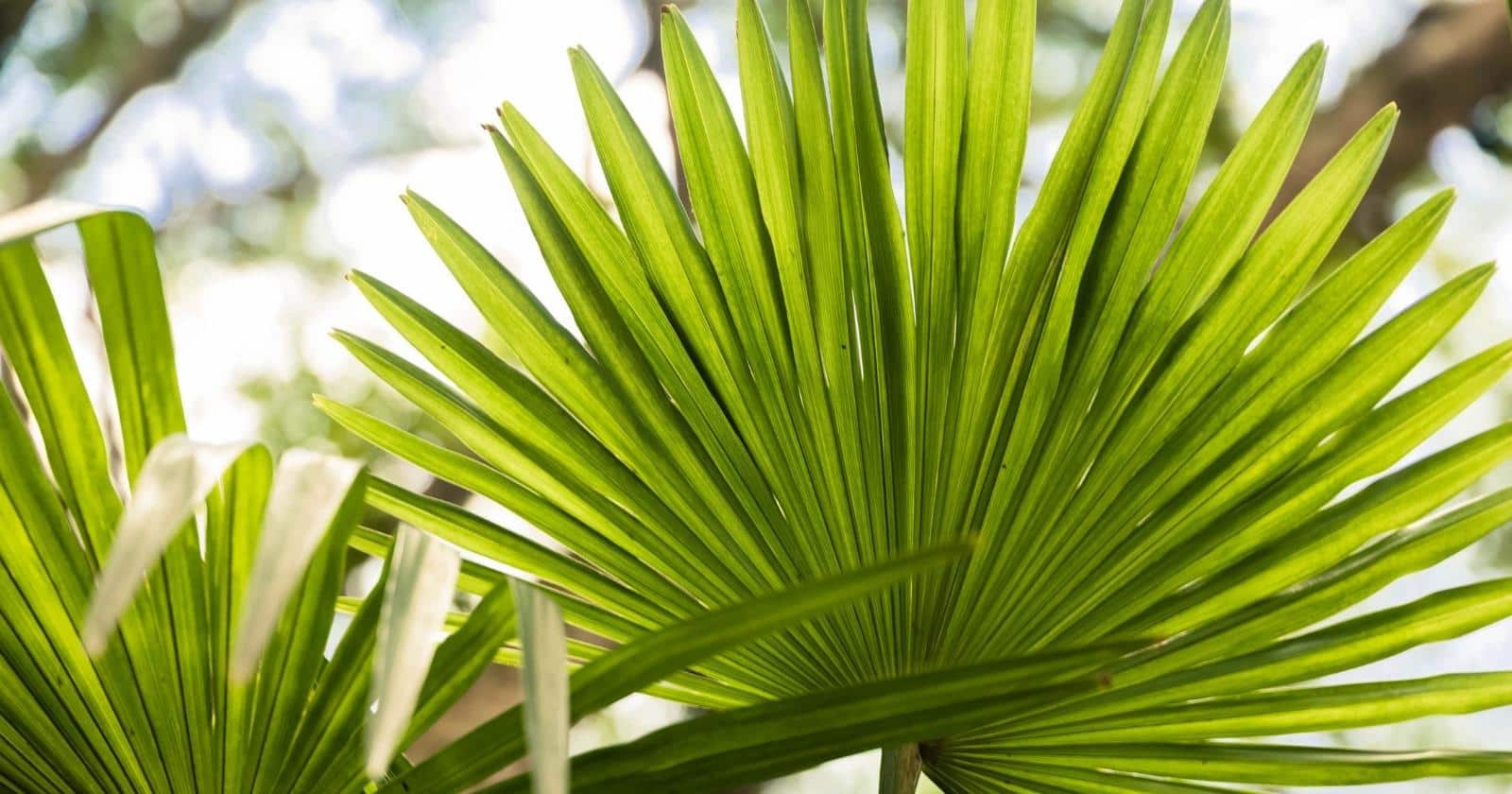
Leave a comment